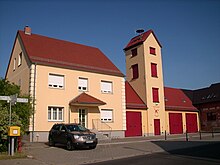Sellessen
|
Sellessen
Zelezna City of Spremberg
Coordinates: 51 ° 36 ′ 11 " N , 14 ° 24 ′ 4" E
|
|
|---|---|
| Height : | 125 m above sea level NN |
| Area : | 22.62 km² |
| Residents : | 830 (Jan. 1, 2018) |
| Population density : | 37 inhabitants / km² |
| Incorporation : | September 27, 1998 |
| Postal code : | 03130 |
| Area code : | 03563 |
|
Location of Sellessen in the city of Spremberg
|
|

Sellessen , Zelezna in Lower Sorbian (also Železna in dialect ), is a district of the Brandenburg town of Spremberg in the Spree-Neisse district in the south of Niederlausitz .
geography
Sellessen is about 5 km north of the town of Spremberg. The place is made up of the three districts Sellessen, Muckrow and Bühlow . The independent district Haidemühl , which also belongs to the town of Spremberg, is located in the Sellessen area . Due to the ongoing Welzow-Süd opencast mine , this was officially relocated here on January 1, 2006. The majority of the Haidemühler population opted for the location in Sellessen from several alternatives. On October 26, 1999, the Haidemühl municipal council decided to relocate to Sellessen. Haidemühl is completely enclosed by the Sellessen district.
Sellessen is located west of the Muskau folds and is accessible by road 47 and 52. The federal road 97 is only 500 m away from the district Bühlow, which leads north to Cottbus, 20 km away, and south to Spremberg, 4 km away.
Surrounding villages are Groß Luja in the east, Weskow and the urban area Spremberg in the south. To the west, Sellessen borders the devastated districts of Groß Buckow and Klein Buckow . In the north to the community of Neuhausen / Spree .
history
Sellessen is located in the Sorbian / Wendish settlement area and is called Zelezna in Lower Sorbian, from Zelezo for "iron".
The first documentary mention of Sellessen goes back to the year 1350 as a place with the name Selesne . However, the first traces of settlement can be traced back to 200 AD, when lawn iron ore was smelted . The main livelihood of the population was agriculture until the industrial revolution . With the onset of industrialization, it was then also possible to earn a living in the nearby pits , the cloth and other factories in Spremberg. In 1873 a large fire caused considerable damage to the village. Bühlow, which was first mentioned in 1572 as Belo , was affected by floods and floods in 1897 and 1899. In October 1938, the previously independent community of Muckrow was incorporated into Sellessen. Muckrow was first mentioned as Mokraw in 1527 . The end of the Second World War came for Sellessen on April 20, 1945 with the invasion of the troops of the 1st Ukrainian Front . Between 1958 and 1965, the Spremberg dam was built north of Sellessen , the primary task of which today is flood protection. In June 1973, the previously independent Bühlow was incorporated into Sellessen by a district council resolution. From May 1992 Sellessen belonged to the Office Hornow / Simmersdorf . On September 27, 1998 Sellessen was incorporated into the town of Spremberg as a district by referendum.
Infrastructure and sights
Despite its village character, Sellessen has seen large industrial settlements, especially after the political change in 1989 . The biomass cogeneration plant of the Gesellschaft für Montan- und Bautechnik mbH, a subsidiary of LEAG , should be mentioned in particular . Furthermore, in the commercial area built after 1990, there are various craft businesses and a branch office for vehicle registration for the Spree-Neisse district .
The town of Haidemühl, which in its entirety is an example of successful resettlement in Lusatia, is one of the sights today .
Web links
Individual evidence
- ^ Districts of the city of Spremberg. In: stadt-spremberg.de. Retrieved February 7, 2018 .
- ↑ Law on the state-wide municipal area reform concerning the districts of Dahme-Spreewald, Elbe-Elster, Oberspreewald-Lausitz, Oder-Spree, Spree-Neiße as well as the dissolution of the municipalities of Diepensee and Haidemühl and the amendment of the law for the dissolution of the municipality of Horno and the integration of their municipality to the municipality of Jänschwalde and to change the official regulations. (PDF; 3.1 MB) Landtag Brandenburg, November 1, 2002, accessed on March 21, 2017 .

